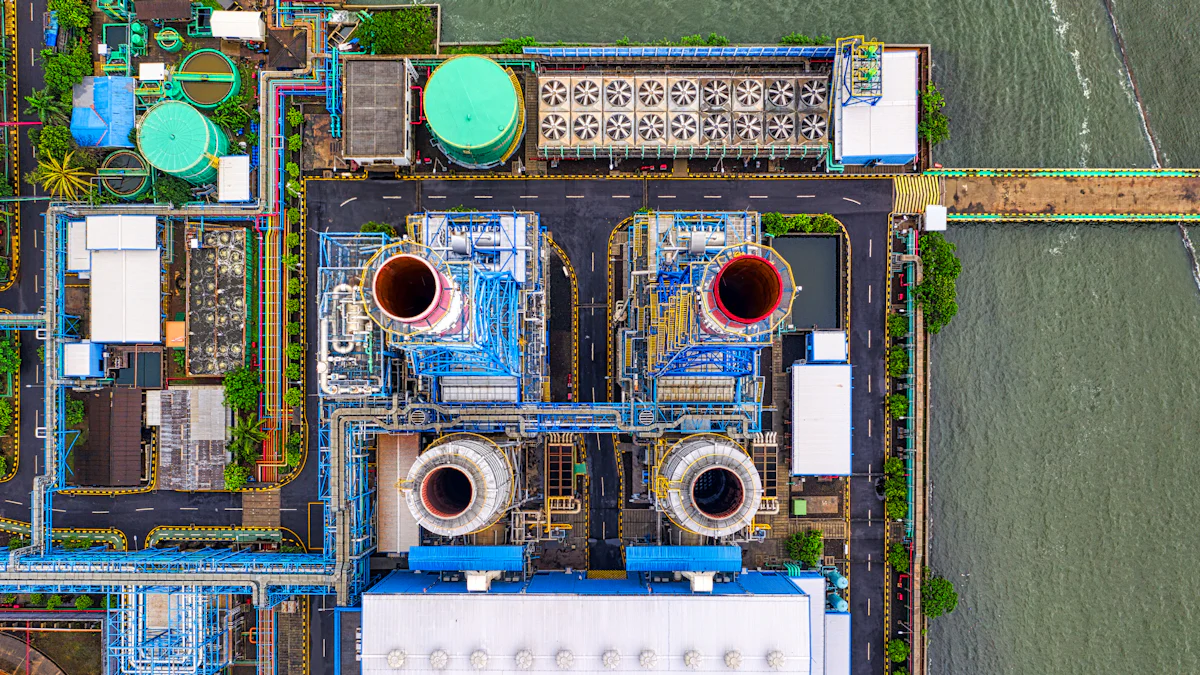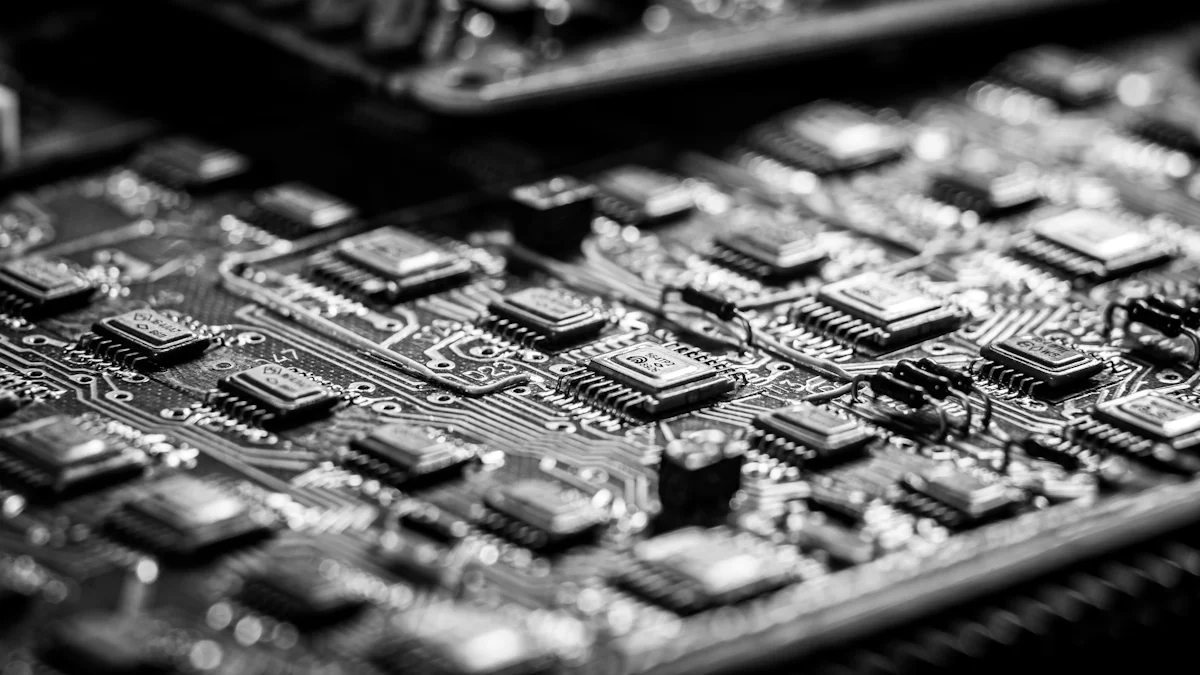
Aixtron’s cutting-edge reactor components, such as the AIX G5+ C and G10-GaN systems, are revolutionizing the semiconductor industry. These innovations enhance material deposition precision and scalability, enabling breakthroughs in power electronics and optoelectronics. The G10-GaN system, for instance, is projected to drive over 50% of Aixtron’s GaN revenues in 2024, reflecting its transformative impact. By integrating advanced technologies like In-Situ Cleaning and automation, Aixtron reactor components not only improve production efficiency but also contribute to sustainability. These advancements pave the way for emerging technologies, including quantum computing and 5G infrastructure.
Key Takeaways
- Aixtron’s advanced reactor components, like the AIX G5+ C and G10-GaN systems, are transforming semiconductor manufacturing by enhancing precision and scalability.
- The integration of AI and automation in Aixtron reactors improves production efficiency, reduces downtime, and ensures consistent quality in material deposition.
- Sustainability is a key focus, with innovations such as In-Situ Cleaning technology that minimize energy consumption and material waste during manufacturing.
- Aixtron’s reactors support high-volume production, making them ideal for industries like power electronics and optoelectronics, which demand rapid innovation.
- Emerging technologies, including quantum computing and 5G infrastructure, benefit from Aixtron’s precise material deposition capabilities, paving the way for future advancements.
- By utilizing advanced materials and innovative designs, Aixtron reactors enhance durability and thermal stability, crucial for high-temperature semiconductor applications.
- Investing in Aixtron’s reactor technology can lead to higher yields and lower operational costs, making it a valuable asset for manufacturers aiming for efficiency and sustainability.
Overview of Aixtron Reactor Technology
Aixtron Reactor Components and Their Applications
Aixtron reactors play a pivotal role in material deposition and semiconductor production. These reactors utilize advanced Metal Organic Chemical Vapor Deposition (MOCVD) technology to create thin films with exceptional uniformity and precision. The AIXTRON AIX 2600 G3 HT, for instance, employs an innovative Inverted-L geometry, ensuring substrates are optimally positioned for semiconductor thin film growth. This design enhances deposition rates and guarantees high-quality coatings, meeting the rigorous demands of modern semiconductor manufacturing.
The applications of Aixtron reactor components span multiple industries. In the microLED sector, these reactors enable the production of high-performance displays with superior brightness and energy efficiency. Power electronics benefit from the reactors’ ability to deposit materials like gallium nitride (GaN), which supports the development of compact, high-power devices. Optoelectronics also leverage Aixtron’s technology to manufacture components such as lasers and photodetectors, essential for telecommunications and sensing applications.
Importance of Aixtron Reactor Components
Aixtron reactor components significantly enhance material quality and production efficiency. The integration of features like gas source molecular beam epitaxy (GSMBE) ensures even film growth and excellent step coverage. This capability allows manufacturers to produce epitaxial layers with remarkable uniformity and reproducibility. Additionally, the reactors’ advanced gas distribution systems and precise control over deposition parameters reduce material waste, optimizing resource utilization.
Precision and scalability are critical in advanced manufacturing, and Aixtron excels in both areas. Systems like the AIXTRON AIX 2600 G3 HT support high-throughput production, enabling manufacturers to meet growing market demands. The reactors’ semi-automatic loading and unloading systems streamline operations, minimizing downtime and ensuring consistent output. By combining precision engineering with scalable solutions, Aixtron empowers industries to innovate and expand efficiently.
Recent Advancements in Aixtron Reactor Components

Innovations in Material Efficiency and Precision
Aixtron continues to lead the industry with advancements in material efficiency and precision. The development of advanced materials, such as silicon carbide and tantalum carbide coatings, has significantly improved the performance of their reactors. These materials enhance durability and thermal stability, making them ideal for high-temperature applications in semiconductor manufacturing. By incorporating these coatings, Aixtron ensures that their reactors deliver consistent results even under demanding conditions.
The AIX G5+ C reactor exemplifies Aixtron’s commitment to reducing material waste. Its innovative design optimizes gas flow distribution, ensuring uniform deposition across substrates. This precision minimizes the consumption of raw materials, which not only reduces costs but also aligns with sustainability goals. Manufacturers benefit from higher yields and lower operational expenses, making the AIX G5+ C a valuable asset in modern production environments.
Enhanced Scalability and Production Capabilities
Aixtron has introduced high-capacity systems like the CRIUS(R) II-L to address the growing demand for large-scale production. This reactor, recognized as one of the largest capacity MOCVD systems available, supports high-throughput manufacturing. Its design accommodates multiple wafers simultaneously, enabling manufacturers to scale up production without compromising quality. This capability is particularly beneficial for industries like power electronics and optoelectronics, where demand for advanced components continues to rise.
The adaptability of Aixtron reactors further enhances their scalability. Systems like the G10-GaN are designed to meet high-volume manufacturing requirements. This compact MOCVD cluster tool supports the production of GaN devices on both 150mm and 200mm wafers, offering flexibility to manufacturers. By catering to diverse production needs, Aixtron ensures that their reactors remain relevant in a rapidly evolving market.
Integration of AI and Automation in Aixtron Reactor Components
Aixtron has embraced artificial intelligence (AI) and automation to revolutionize reactor performance. The G10-AsP system, for instance, utilizes AI for real-time monitoring and optimization. This technology analyzes data during the deposition process, allowing the system to make adjustments that enhance precision and efficiency. Manufacturers benefit from improved process stability and reduced variability, which are critical for producing high-quality components.
Automation advancements in Aixtron reactors have also minimized downtime and streamlined operations. Features like automated wafer handling and in-situ cleaning reduce manual intervention, ensuring consistent performance. These innovations not only improve reactor uptime but also enhance overall productivity. By integrating AI and automation, Aixtron has set a new standard for efficiency and reliability in semiconductor manufacturing.
Industry Impacts of Advancements in Aixtron Reactor Components

Benefits for Semiconductor Manufacturing
Aixtron reactor components have transformed semiconductor manufacturing by enabling the production of high-performance chips and devices. The introduction of multi-wafer reactors, such as the Aixtron 200 series, has addressed the increasing demands of high-volume chipmakers. These reactors ensure consistent quality across multiple wafers, meeting the stringent requirements of advanced semiconductor fabrication.
The support for advanced node technologies further highlights the importance of Aixtron’s innovations. Systems like the AIX G5+ have introduced a 5×200 mm GaN-on-Si technology package, which enhances the scalability and precision of semiconductor production. This advancement allows manufacturers to produce chips with higher efficiency and performance, catering to the needs of cutting-edge applications in computing and communication.
Implications for Emerging Technologies
The advancements in Aixtron reactor components have significantly contributed to the development of emerging technologies. In quantum computing, the precise material deposition capabilities of Aixtron systems enable the creation of high-quality quantum dots and other essential components. These innovations play a crucial role in advancing quantum technologies, which require unparalleled precision and material uniformity.
In the realm of 5G infrastructure, Aixtron’s reactors support the production of GaN-based devices, which are vital for high-frequency and high-power applications. Projects like All2GaN have optimized large-scale diameter MOCVD systems, accelerating the adoption of GaN devices in RF communication markets. Additionally, Aixtron’s reactors facilitate advancements in microLED production, enabling the development of next-generation display technologies with superior brightness and energy efficiency.
Environmental and Energy Efficiency Improvements
Aixtron’s commitment to sustainability is evident in the design of its reactor components. The integration of sustainable features, such as In-Situ Cleaning technology, reduces energy consumption during the manufacturing process. This innovation minimizes downtime and ensures efficient reactor operation, contributing to lower overall energy usage.
The reduction of environmental impact is another key achievement of Aixtron’s advancements. The innovative design of chemical vapor deposition (CVD) reactors influences thermal coupling and heat flow, optimizing energy efficiency. By facilitating large-scale epitaxial deposition on 200/300 mm wafers, systems like the CCS 2D MOCVD reactor further enhance resource utilization. These efforts align with global sustainability goals, making Aixtron a leader in environmentally conscious manufacturing.
Aixtron reactor components, including the AIX G5+ C and G10-GaN systems, represent a significant leap in semiconductor manufacturing technology. These advancements have redefined precision, scalability, and efficiency, enabling industries to innovate in power electronics, optoelectronics, and beyond. By focusing on productivity and addressing fast-growing markets, Aixtron ensures its technologies remain viable for emerging applications like quantum computing and 5G infrastructure. Furthermore, the integration of sustainable practices highlights Aixtron’s commitment to resource efficiency and environmental responsibility, paving the way for a more sustainable and technologically advanced future.
FAQ
What are the advantages of AIXTRON’s MOCVD systems?
AIXTRON’s MOCVD systems offer several key benefits. The Planetary Reactors® and Shower Head reactors stand out for their user-friendly operation and exceptional process stability. These systems achieve the highest precursor efficiencies and deliver unparalleled uniformity in material deposition. Their advanced design ensures consistent performance, making them a preferred choice for semiconductor manufacturers worldwide.
How does AIXTRON contribute to the All2GaN project?
AIXTRON plays a pivotal role in the All2GaN project by leveraging its expertise in large-scale diameter MOCVD systems. These systems undergo optimization to achieve higher throughput, facilitating the faster adoption of GaN devices in power switching and RF communication markets. This contribution aligns with global efforts to reduce the carbon footprint by enabling energy-efficient technologies.
"The All2GaN project exemplifies how innovation in reactor technology can drive sustainability and efficiency in emerging markets."
What is the YESvGaN project, and what does it aim to achieve?
The YESvGaN project focuses on developing a new class of wide-bandgap (WBG) power transistors based on gallium nitride (GaN). These transistors, known as vertical GaN (vGaN) membrane transistors, aim to combine affordability with high efficiency. Designed for voltage conversion up to 1200 V and currents up to 100 A, this innovation promises to revolutionize power electronics by offering compact and cost-effective solutions.
Why is gallium nitride (GaN) important in semiconductor manufacturing?
Gallium nitride (GaN) has become a cornerstone material in semiconductor manufacturing due to its superior properties. It supports the development of high-power, high-frequency devices essential for applications like 5G infrastructure, power electronics, and optoelectronics. GaN’s ability to operate at higher voltages and temperatures makes it indispensable for next-generation technologies.
What industries benefit most from Aixtron’s reactor advancements?
Aixtron’s reactor advancements impact several industries, including:
- Semiconductor manufacturing: Enhanced production of high-performance chips.
- Power electronics: Development of compact, energy-efficient devices.
- Optoelectronics: Manufacturing of lasers, photodetectors, and microLEDs.
- Emerging technologies: Contributions to quantum computing and 5G infrastructure.
These industries leverage Aixtron’s innovations to meet growing demands and achieve technological breakthroughs.
How do Aixtron reactors support sustainability?
Aixtron integrates sustainable features into its reactors, such as In-Situ Cleaning technology, which reduces energy consumption and minimizes downtime. The optimized designs of chemical vapor deposition (CVD) reactors enhance thermal efficiency and resource utilization. These efforts align with global sustainability goals, ensuring environmentally conscious manufacturing processes.
What makes Aixtron’s reactors suitable for large-scale production?
Aixtron’s reactors, such as the CRIUS(R) II-L, are designed for high-capacity manufacturing. These systems accommodate multiple wafers simultaneously, enabling large-scale production without compromising quality. Their adaptability to diverse production needs ensures scalability, making them ideal for industries with high-volume demands.
How does Aixtron integrate AI and automation into its reactors?
Aixtron incorporates artificial intelligence (AI) and automation to enhance reactor performance. Systems like the G10-AsP utilize AI for real-time monitoring and optimization, ensuring precision and efficiency during material deposition. Automated features, such as wafer handling and in-situ cleaning, streamline operations and reduce manual intervention, improving overall productivity.
What role does Aixtron play in advancing microLED technology?
Aixtron’s reactors enable the production of high-performance microLEDs, which offer superior brightness and energy efficiency compared to traditional displays. The AIX G5+ C reactor, for instance, supports the precise deposition of materials required for microLED manufacturing. This advancement drives innovation in display technologies, catering to applications in consumer electronics and beyond.
How does Aixtron ensure the quality of its reactor components?
Aixtron prioritizes precision engineering and rigorous testing to ensure the quality of its reactor components. Advanced features, such as gas source molecular beam epitaxy (GSMBE) and optimized gas flow distribution, guarantee uniform material deposition. These measures ensure consistent performance, meeting the stringent requirements of modern semiconductor manufacturing.